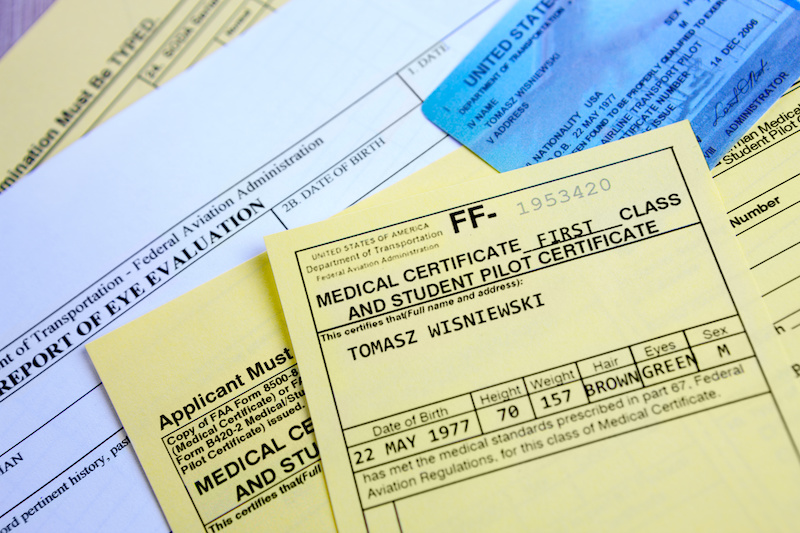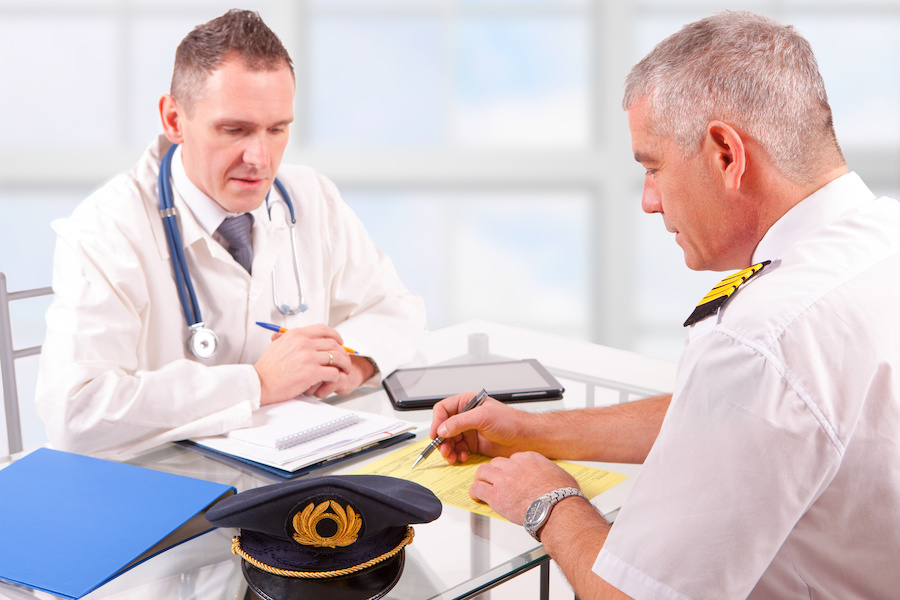

Pilot health constitutes a crucial safety element in aviation.
Most aviators require some proof of medical fitness to exercise the privileges of their airman certificate, which often entails passing a medical exam and meeting specific medical standards.
The pilot medical certification in the U.S. falls into three categories: FAA medical certificate, U.S. driver’s license, or BasicMed.
Which one do you need? It depends on the type of your pilot certificate.
Ready to learn about one of the most important aspects of your life as a pilot?
Let’s start with the basics first.
An FAA airman medical certificate is “acceptable evidence of physical fitness on a form prescribed by the Administrator.” It’s an official document issued by an FAA-designated Aviation Medical Examiner (AME) to demonstrate that you meet the appropriate medical standards to exercise the privileges of your pilot certificate.
Obtaining the certificate entails passing a medical exam, also known as flight physical, and meeting certain medical requirements.
The FAA requires most pilots to have their medical certificate on their person or in the aircraft. Here’s a list of the types of airmen required to hold a medical certificate:
However, the medical certificate isn’t required if you’re one of the following:
You may also use a U.S. driver’s license or a medical certificate if you’re a student, sport pilot, flight instructor, or examiner in light-sport aircraft.
Moreover, A U.S. driver’s license suffices if you’re a student, recreational, or private pilot, or flight instructor (acting as the pilot in command or as a required flight crewmember) if the aircraft, flight, and pilot meet certain conditions and limitations.

In the United States, you must follow these steps to get your FAA medical certificate:
Let’s talk about the medical exam before we explore the medical certificates in more detail.
First, you need to find an FAA AME and book an appointment. You may ask fellow pilots or flight instructors for recommendations, or you could use the FAA’s “Find an Aviation Medical Examiner” portal to locate an AME.
The examiner often starts the exam with questions about your recent medical history, including any hospital visits, surgeries, or medications.
The medical exam consists of a series of tests, examining your vision, hearing, blood pressure, pulse, urine, and general health among other areas. It may include an ECG if you’re 35 years of age and older and applying for a first-class medical certificate.
Moreover, the AME will ask questions about your mental health to determine your psychological fitness.
How long does it take to complete your medical exam?
Generally, your medical exam takes between 15 and 30 minutes if you have no medical condition or irregularities during the exam (e.g., high blood pressure).
You should bring the following items to your flight physical:
The FAA doesn’t publish a fixed examination fee, instead, it recommends that the fee should be usual and customary. The cost varies depending on the examiner, location, and class of medical certificate. Most AMEs charge $75 to $150 per exam, and a first-class medical examination can cost up to $200.
Your AME may issue, defer, or deny your application for a medical certificate:
Your examiner should issue a medical certificate if you meet the required medical standards for the class.
Your AME should defer your application to the FAA for action if they have any concerns about your medical eligibility or history.
The examiner will deny certification if the applicant clearly doesn’t meet the medical standards. It is a rare occurrence, though, denial accounts for roughly 0.1 percent of more than 450,000 applications for the FAA medical certificate annually.
However, An AME’s denial of a medical certificate is not a final FAA denial. You may appeal the examiner’s decision by submitting a request for consideration to the FAA’s Aerospace Medical Certification Division.
Here are a few tips to get you through your medical examination seamlessly:
A medical examiner who does hundreds of exams each year can help you navigate the application, examination, and regulation nuances. Ask around for recommendations and check online for reviews.
Get enough sleep, keep yourself hydrated, and avoid any food or beverage that’s high in caffeine, sodium, or sugar and stay away from tobacco and stimulants for eight hours before your medical exam.
Make sure you have all the pertinent items, such as your photo ID, medical records, and corrective lenses. Generally, the more documentation available, the faster the certification process.
Don’t wait until the last few days before your medical certificate expires to complete your exam. You may not be able to schedule an appointment with an AME for some reason.
An AME who’s familiar with you and your medical history makes for smooth medical examination and certification. Find an examiner you’re comfortable with and stick with them.
So, you know what to expect and how to prepare for your medical exam.
Let’s discuss the medical certificate classes.
Medical certificates for pilots come in three classes: first, second, and third.
Each class has its standards and requirements, which include thresholds for vision, hearing, and blood pressure. Moreover, all classes require having no diagnosis, medical history, medication, or treatment for certain health conditions, diseases, and defects that may interfere with the person’s ability to fly safely.
Here’s a summary of the medical requirements for each class:
| Class | First | Second | Third |
| Eye | Normal fields of vision with no acute or chronic pathological condition of either eye that interferes with the proper function of an eye | ||
Minimum visual acuity in each eye separately, with or without corrections
Demonstrate an acceptable understanding of speech as determined by audiometric speech discrimination with a score of at least 70 percent obtained in one ear or in a sound field environment
Provide acceptable results of pure tone audiometric testing of unaided hearing acuity
A first-class medical certificate is a requirement for airline transport pilots. It has the most stringent medical standards.
The FAA designates the second-class medical certificate for commercial pilots. It has the same medical standards required for the first, but with one exception:
You’re not required to conduct an electrocardiogram.
The third-class medical certificate is the minimum certification for student, recreational and private pilots. It’s quite similar to the second, but your vision doesn’t have to be as sharp.
Distant vision must be 20/40 or better and there’s no requirement for intermediate vision.
You’re familiar with the classes, but how long is an FAA medical certificate good for?
| Medical Certificate | Airman | Age (on or before the date of examination) | Validity (in calendar months) |
| First Class | Airline Transport Pilot | 40 or over | 6 |
| Below 40 | 12 | ||
| Second Class | Commercial Pilot | Any | 12 |
| Third Class | Private, Recreational, and Student Pilots | 40 or over | 24 |
| Below 40 | 60 |
The validity of your medical certificate depends on two factors: Age and operation type.
See, you may exercise the privileges of a lower airman certificate, which changes the validity period.
Here’s an example:
Suppose you’re an airline pilot with an ATP certificate. In this case, your medical certificate is valid for 6 months if you’re age 40 or older. However, the validity period becomes 24 months if you’re exercising private pilot privileges. Say, flying a Cessna 150 to a nearby island on weekends.
Good, but you should know that many medical conditions would render you ineligible for a medical certificate.
Chest pain or discomfort due to the heart’s arteries inability to deliver enough blood to the heart, which usually happens because one or more of the arteries is narrowed or blocked.
A mental health condition that causes extreme mood swings, which range from depression to mania. It causes changes in sleep, energy, and behavior.
A replacement of one or more aortic valves with a mechanical valve or a biological valve made from cow, pig, or human heart tissue.
A heart disease where the coronary arteries become too narrow or blocked, reducing the blood flow to the heart.
A medical term (commonly known as diabetes) that describes several metabolic disorders that cause high blood sugar.
Impaired or complete loss of consciousness can lead to partial or total incapacitation, which poses obvious safety hazards.
A neurological disorder in which brain activity becomes abnormal, causing unprovoked, recurrent seizures.
A transplant surgery which replaces a damaged or failing heart with a healthy one from an organ donor.
A medical term for a heart attack, which occurs when blood flow decreases or stops to a part of the heart.
A medical device that generates electrical impulses delivered to cause the heart muscle chambers to maintain an adequate heart rate.
A mental disorder characterized by inflexible and atypical patterns of thinking, feeling, and behaving.
A mental disorder that causes difficulties in the perception or interpretation of reality with the possible occurrence of hallucinations or delusions among other symptoms.
Harmful use or misuse of alcohol, medication, or drugs, which makes the person unable to fly safely. The FAA also defines substance abuse as a verified positive drug test result, an alcohol test result of 0.04 or greater alcohol concentration, or a refusal to submit to a drug or alcohol test.
A condition in which a person is dependent on a substance other than tobacco or ordinary xanthine containing (e.g., caffeine) beverages.
The temporary loss of one or more of nervous system functions, for example, the ability to control movement.
Other medical conditions can also be temporarily or permanently disqualifying, such as acute infections or physical defects that may interfere with safe flight.
However, the FAA may grant special issuance based on individual considerations.

Can you obtain a medical certificate even if you suffer from a disqualifying condition?
Yes, you may be eligible for a discretionary issuance of a certificate.
The FAA’s medical division reviews cases, often requiring more documents than what’s usually requested, including doctor’s report, medical records, and blood tests to determine the applicant’s eligibility for a special issuance of a medical certificate.
A special issuance is an authorization granted by the FAA, at the discretion of the Federal Air Surgeon, to applicants who don’t meet medical standards for the first, second, or third class.
You may have to pass a special medical flight test, practical test, or medical evaluation to obtain the authorization. You must also show that you’re able to perform your airman duties authorized by the class of medical certificate sought without endangering public safety. The authorization is valid for a limited duration and requires renewal.
Renewing your special issuance requires going through an AME Assisted Special Issuance (AASI).
An AASI is a process that permits examiners to re-issue an airman medical certificate based on an authorization to pilots with disqualifying medical conditions if the applicant provides the requisite medical information. The AME’s decision is subject to review by the FAA.
On the other hand, a Statement of Demonstrated Ability (SODA) is a statement authorizing medical certification of, at the discretion of the Federal Air Surgeon, applicants whose disqualifying condition is static or non-progressive. You must also prove your capability of flying safely through the successful completion of a practical test. A SODA doesn’t expire.
Both provisions authorize a designated AME to issue a medical certificate of a specified class if the condition hasn’t adversely changed.
Special issuance, SODA, and the medical certificate may state operational limitations for safety.
This brings us to the next point.
@pilotinstituteairplanes
Limitations placed on a medical certificate are essentially prerequisites for pilots who don’t meet the minimum medical standards for the class. A common limitation is “Must wear corrective lenses” for pilots who need glasses or contacts to achieve the required visual acuity.
The FAA language uses restrictions and limitations interchangeably, but restrictions are often limitations on the airman’s operational privileges or validity period of the medical certificate. Here are a few examples:
Pilots with color vision deficiencies, including color blindness, typically have the “Not valid for night flying or by color signal control” restriction on their medical certificate.
Next, let’s delve into the latest addition to medical certification.
BasicMed is an alternate way for pilots to demonstrate medical eligibility to fly without holding an FAA medical certificate.
It came into effect in May 2017, and now years later, more than 60,000 pilots fly under the regulatory relief.
Who can fly under BasicMed?
Student, recreational, and private pilots, in addition to flight instructors when acting as pilot in command (PIC).
BasicMed allows you to exercise the privileges associated with a third-class medical certificate, but with the following limitations:
BasicMed’s validity differs from a medical certificate’s. While the latter’s expiry depends on the age and type of operation, keeping your BasicMed valid requires meeting the following:
You must also have passed a flight review within the past 24 months to exercise the privileges of your pilot certificate. Therefore, a valid and current flight review is a requirement to fly under BasicMed.
Now let’s answer a few common questions.
Yes, you may wear corrective lenses (glasses or contacts) if you’re a pilot, but you should always carry a spare pair when flying. You can also get LASIK eye surgery, although you should consult an AME prior.
Normally, you’d receive your medical certificate upon the conclusion of your medical exam, which takes no more than 30 minutes in most cases. However, it may take days, weeks, or even months if you’re applying for special issuance medical certificate.
There are no minimum or maximum ages, you’re eligible for it as long as you pass your medical exam. However, because 16 years of age is required for the issuance of a student pilot certificate, any applicant below that age would have no use for a medical certificate.
You can request a permanent replacement certificate online or by mail, which costs $2 and takes up to 10 days for online processing and 6 weeks for mail processing. You could also receive a temporary medical certificate by contacting the Aerospace Medical Certification Division (AMCD) call center. You’d often receive it the same day via fax or email and it’s valid for 60 days.
Yes, you can become a pilot if your condition is adequately controlled and you’re able to demonstrate that it won’t affect your ability to fly safely. Some conditions are initially disqualifying, but the FAA may still grant you a medical certificate under the provision of special issuance.
IMSAFE is a mnemonic recommended for pilots to determine physical and mental readiness for flying. Here’s what each letter stands for:
Each of these elements can impair your judgment, which may bring about deadly safety hazards.
You should make sure that none of them is affecting you before every flight. It’s recommended to avoid alcohol for at least 8 hours before you fly, although many airlines require a minimum of 12.
Stress and emotion can be tough to eliminate, but try your best to manage them.
Apart from the regulations, you’re ethically and legally responsible for flying only when you’re fit to operate an aircraft safely without endangering the public, passengers, crew, or yourself.
You must always ensure that your proof of medical fitness is valid and current, be it an FAA medical certificate, U.S. driver’s license, or BasicMed.
You must also comply with all limitations or restrictions associated with your certification.
Poor health, fatigue, or stress may cause errors in judgment with catastrophic consequences.
Pay close attention to your mental and physical health, and never hesitate to see a doctor if you’re feeling unwell.
Make sure you’re in good shape through a healthy diet, regular exercise, and adequate sleep.
Being a healthy, medically fit pilot is a lifestyle.